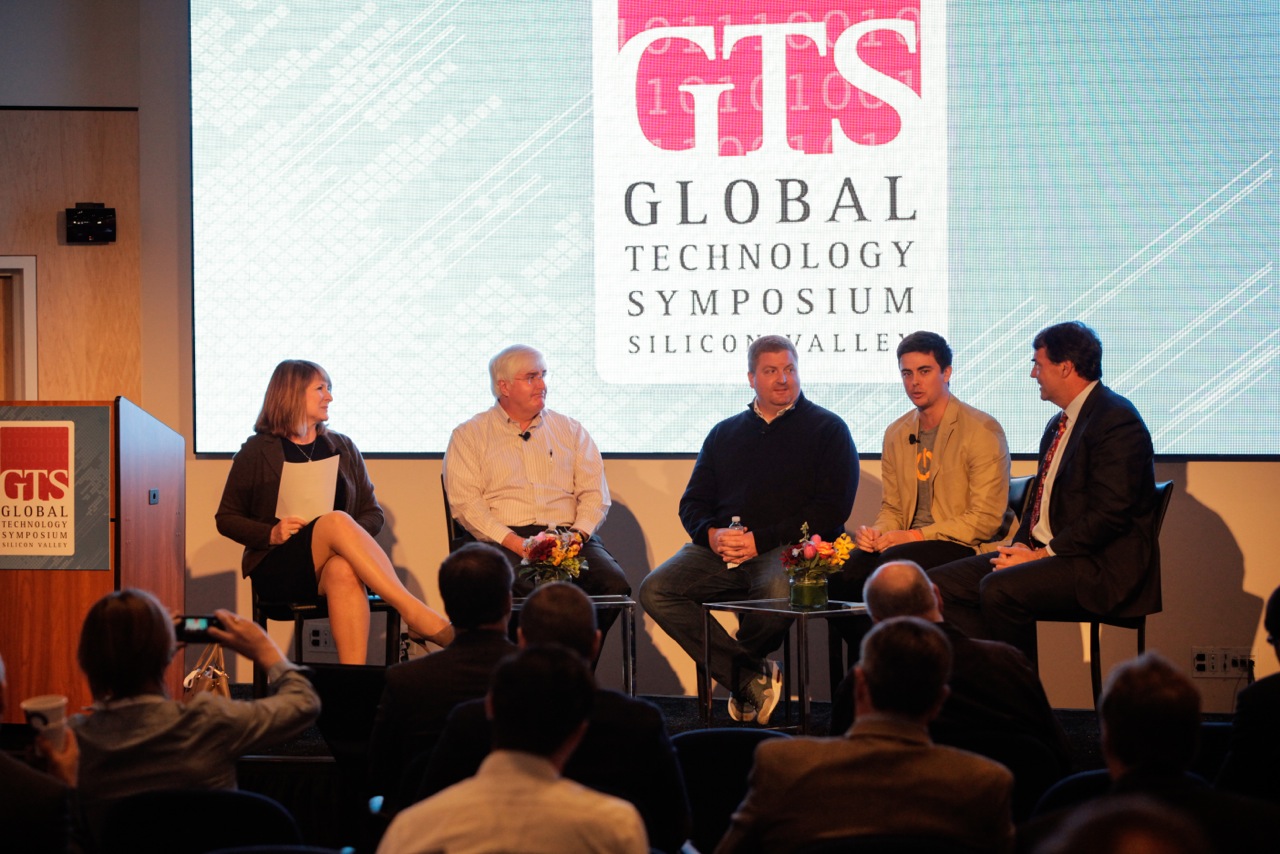During the Global Technology Symposium on Thursday, moderator Heidi Roizen referred to a panel that included Ron Conway, founder of SV Angel; Ronny Conway, founder of A Capital; Adam Draper, CEO of Boost VC accelerator; and Tim Draper, founder of DFJ and Draper University of Heroes as the “first multifamily, multigenerational rock star panel.”
The father-son combos made for an entertaining and educating session.

Ron Conway told the audience he was born in San Francisco, raised his family on the Peninsula and met the Draper family when their children attended school together at St. Joseph. He started SV Angel in 1994, initially teaming up with Ben Rosen. Part of why he began angel investing was because of the encouragement he received from Don Valentine and Pitch Johnson. Since then, SV Angel has invested in 700 startups.
Ronny Conway said he grew up listening to his dad talk constantly about startup companies. After graduating in 2003, he worked at Google and was the first employee at Google Ventures. When he heard that Marc Andreessen and Ben Horowitz were starting up Andreessen Horowitz (A16Z), he started working there. He headed their early-stage portfolio the past four years. While at A16Z, he learned a lot through osmosis. That is also when he realized he wanted to do venture the rest of his life. A Capital, which he founded, does exactly what its name implies—it invests in companies at the Series A stage.
Tim Draper said he met Heidi Roizen at Stanford when they were in the same freshman dorm. He got to know the Conways in many ways, but mostly on the sports field. After starting DFJ and setting up a network of venture firms around the world, he decided to take some time off to start Draper University and his Six Californias initiative. The initiative stems from his belief that California needs a fresh start, that “Sacramento has gotten rusty and is not responsive to Silicon Valley.”
Adam Draper said he grew up as friends with Topher Conway, and fell in love with tech in seventh grade when he became enamored with Napster. Coincidentally, Ron Conway and SV Angel had invested in Napster. While attending UCLA, he founded a company called Expert Financial, where he worked for four years. That experience taught him a lot, and at Boost he has tried to impart those hard earned lessons to other entrepreneurs. He said Boost VC provides “housing and office space for a three month program.” Boost brings in mentors and speakers, and has a big focus on Bitcoin. He was an early investor in Coinbase, and at Draper University there is an Bitcoin ATM.
The speakers joked how entrepreneurs can start at Draper University of Heroes, then go to the Boost accelerator program, then receive angel investment from SV Angel, and then an A round from DFJ.
Ron Conway said that in the early days he would see all of the companies and do all the due diligence. But now there are six people at SV Angel including Topher Conway, another son. He said they invest in about one out of every 30 companies they see, so if they’ve invested in “700, then we’ve looked at 700 times 30.”
The elder Conway said the typical investment by SV Angel is $50,000 to $200,000 and that they invest in entrepreneurs who are obsessed. He said the startups they look at typically seek to raise a million dollars, and so the entrepreneurs and SV Angel try to find “six to eight other people who will invest $50,000-$100,000 and create a value add syndicate.” He said that they “stack rank” other investors who “will roll up their sleeves.”
Ron Conway said SV Angel rarely writes follow-on checks but will make exceptions for the Google, Facebook, Twitter, Dropbox and Airbnbs. He said that after a couple of years one can tell if a startup has a big breakout. He said SV Angel is unable to do follow-on investments because of the size of their fund. Thus the metric of whether they do a follow-on investment is how the startup is perceived by customers. He said SV Angel only invests out of the Bay Area and New York City.
Tim Draper said that “back in 2004-2006 when no one was funding anything” they had to write extra checks, citing big checks they wrote on Baidu, Skype and Hotmail. He remarked that with Hotmail it “was touch and go the whole way. At the end [before Hotmail was acquired by Microsoft] we were still writing checks” and many people at the time thought we were “burning dollar bills.”
Adam Draper said Boost typically cuts the first check that startups receive, that the companies receive $10,000 to $15,000 and that Boost has to be Darwinian about the future of their companies. In terms of entrepreneurs, they look for scrappiness and/or commitment. Boost tries to find entrepreneurs who would still be working on their startup even if they were living in their parents’ apartment.
The younger Draper then discussed the evolution of Boost, saying that Boost VC has been around for a year. When it first started, they needed three things: office space, good mentors and speakers and good companies. He found that getting the good companies was the hardest task. He joked that in the first session Boost had to “sell the companies, it was us selling them to give them money.” Since, they have received some publicity as Bang With Friends spun out from its first session. He also talked about how Boost accelerator has a Bitcoin thesis and that many of its companies focus on leveraging Bitcoin.
Ronny Conway was asked about his views on Bitcoin and he said that he takes a less thesis-driven approach to investing and more of a market-driven approach. He then answered a question from Roizen about what he learned at Google and whether it was applicable to what he is doing as a venture capitalist. Ronny Conway said that what he learned at Google is how big companies work and less about venture capital. He learned a great deal about venture capital through osmosis whether it be from his father, Google Ventures or Andreessen Horowitz.
He then answered a question from Roizen about A16Z’s agency model by saying there is only one Ben Horowitz and one Marc Andreessen. He added that it is very difficult to execute the agency model effectively and that a venture firm has to be absolutely all in, citing Benchmark as the polar opposite of A16Z. He said that what gets him most excited as an investor is that mobile will be massive because “everyone has a computer in their pocket and tech can now impact the masses,” noting Door Dash and Uber as two companies he really admires.
Roizen asked Ron Conway about his views on venture firms and he remarked that SV Angel “doesn’t think of the VC firm but of the partner at the VC firm.” SV Angel asks, “What partner will mentor this entrepreneur the most?” He cited a couple of examples by noting he believes Alfred Lin at Sequoia would be a great board member at Airbnb because he did Zappos. Similarly, he believes that Roelof Boetha of Sequoia would be a great match for Square because he was an early team member at Paypal and has domain experience.
See part two of our coverage here.
This post was originally published on thedishdaily.com before it was acquired by The Stanford Daily in summer 2014.
